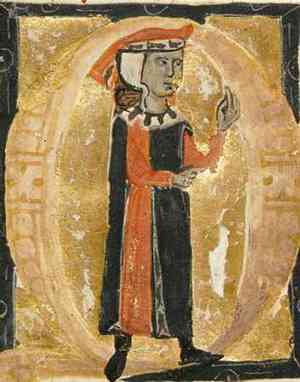


Bernart de Ventadorn
Source:
Todd Tarantino
Born circa 1135 in France, Bernart de Ventadorn (Ventadour) is a good example of the troubadour (itinerant musician). Troubadours had begun plying their craft about the cusp of the eleventh and twelfth centuries and were popular until about the mid-fourteenth century. Troubadours were among the earliest instances of secular music apart from the Church, being poets and singers for whom courtly love was the large topic. As the original popular singers minus record companies, they differed from traveling jugglers and minstrels in that they sought patronage from kings and queens rather than only lords, ladies and anyone else with a purse. Indeed, the first troubadour on record was a count with no need to sing for coins, Guillaume IX, born 60 or so years before Bernart.
Bernart is exemplary of the canso, French at the time for song, variations of which were canco, canzo, canson and eventually chanson in modern French. The canso in Italy was the canto, that is, to chant (sing). What it was in other languages matters not here, since at Bernart's time and for a few centuries to come, to speak of Europe was to refer en large to either Italy or France. Norman (French) rule of England since 1066 was replaced by the even more powerful French family, the Plantagenets, when Henry II was crowned King of England in 1154 during Bernart's youth. The Plantagenets would reign in England until Henry IV, an English Lancaster, in 1399.
Born about the same year as Bernart was the poet, Chrétien de Troyes, the first of the trouvèr(e)s or, troubadours of northern France. The trouvères would form a genre of love song developed by troubadours in Occitan (southern France) called the grand chant, grande chanson courtoise or chanson d'amour. The trouvere enjoyed a status generally more elevated than that of the everyday troubadour. It was also during Bernart's lifetime that trobairitz emerged, that is, female troubadours.
Born in Ventadour, Bernardt's authorship is estimated to range from 1147 to 1180. The same sources have him writing his first poems for the wife of Eble III of Ventadorn, Marguerite de Turenne, making him about age twelve at the time. Bernart eventually fell in love with his patroness. But she a viscount's wife, wisdom persuaded him to leave Ventadour, first for Montluçon, then Toulouse, then England. He was later employed by Count Raimon V of Toulouse. Yet later, Bernart entered a monastery in Dordogne, where he likely died about 1195.
Albeit 45 texts and 19 melodies by Bernard yet exist, his compositions aren't easy to date. Titles below are thus stacked alphabetically. As Bernart spoke Old French of the 8th to 14th centuries he isn't readily translatable while at once variously written. Titles below are per incipits at Trobar by Leonardo Malcovati [below]. Find beneath two widely different interpretations of 'Can vei la lauzeta mover' ('When I see the lark beat his wings') written about 1150 when Bernart was perhaps fifteen.
'Be m'an perdut lai enves Ventadorn' Bernart de Ventadorn
Interpretation above by Millenarium Score
'Can vei la lauzeta mover' Bernart de Ventadorn C 1150
Interpretation above by Alla Francesca
'Can vei la lauzeta mover' Bernart de Ventadorn C 1150
Maria Lafitte w the Ensemble Unicorn & Oni Wytars Ensemble directed by Michael Poscha 1999
'Can par la flors josta.l vert folh' Bernart de Ventadorn
('When flowers appear beneath green leaves')
Guitar: Roland Keunings July 2011 Arrangement for guitar: Alexander Bellow
'La dousa votz ai auzida' ('The Second Vote Is Heard') Bernart de Ventadorn
The Mediaeval Ensemble directed by Michael Best
'Non es meravelha s'eu chan' Bernart de Ventadorn
Guitar: Roland Keunings
Upon the death of Count Raimon V of Toulouse in 1194, Bernart entered a monastery in Dordogne, where he himself likely died about 1195.
Sources & References for Bernart de Ventadorn:
Falck
& Haines
VF History (notes)
Audio of Bernart by Various: Hyperion Internet Archive
Compositions: All Music Trobar (Leonardo Malcovati)
French Song:
Grand Chant (Grand Chant Courtois / Chanson d'amour):
Recordings of Bernart (catalogs):
Discogs Medieval Music Brainz Naxos Presto RYM
Repertoire:
Can vei la lauzeta mover (When I See the Lark Beating Its Wings / c 1150):
Uncommon Courtoisie (Uns chants qui mòu dins la cort)
Sheet Music: Musicalics
Texts: My Poetic Side Poem Hunter Trobar (Leonardo Malcovati)
Can par la flors josta.l vert folh: The Cantos Project
Can vei la lauzeta mover: Groucher College
Troubadours:
Biblography:
Burgwinkle, Hammond & Wilson (The Cambridge History of French Literature 2011)
Antony Easthope (Poetry and Phantasy / Cambridge University Press 1889)
Rosenberg, Switten & Gerard Le Vot (Songs of the Troubadours and Trouveres / Routledge 2013)
Other Profiles: Bobb Edwards OnMusic Dictionary
Classical Main Menu Modern Recording
|
|
hmrproject (at) aol (dot) com